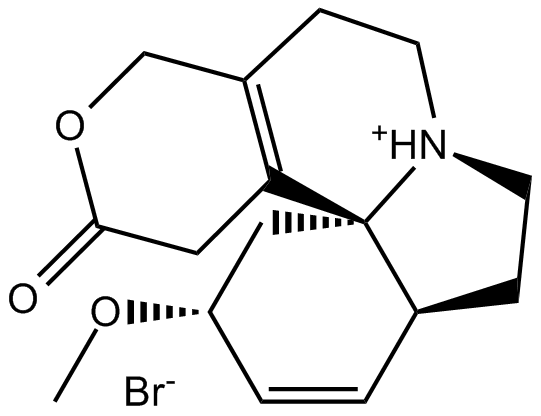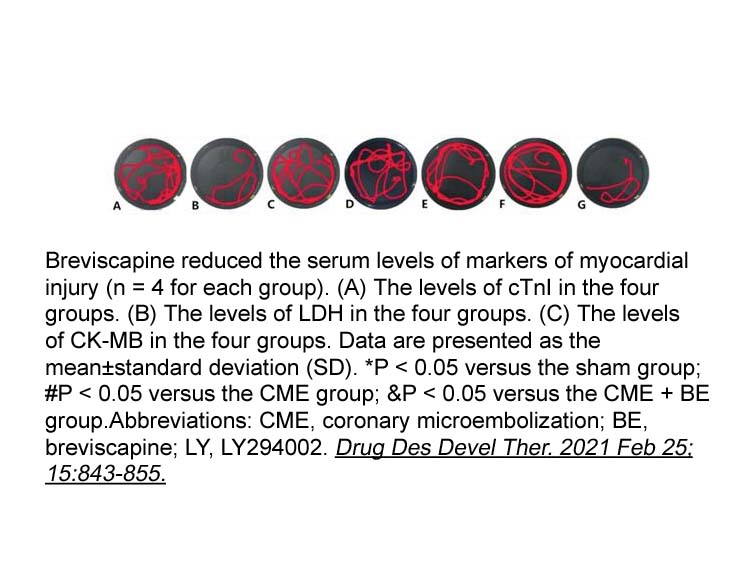Dihydro-β-erythroidine hydrobromide
Dihydro-β-erythroidine hydrobromide (CAS 29734-68-7), abbreviated DHβE, is a competitive antagonist of neuronal nicotinic acetylcholine receptors (nAChRs). Acting directly at nAChR subunits, DHβE blocks acetylcholine-mediated receptor activation in neurons. Its inhibitory potency (IC50) varies by receptor subtype, notably 0.37 μM for α4β2, 0.41 μM for α3β2, and 0.19 μM for α4β4 nAChRs. In vivo studies demonstrate DHβE's capacity to cross the blood-brain barrier, attenuating nicotine-induced central nervous system responses. Due to these antagonist properties, DHβE is frequently utilized as a research tool in studies investigating nAChR function and neuropharmacology.
- 1. Skylar Y. Cooper, Clay V. Willis, et al. "Chemical Flavorants in Vaping Products Alter Neurobiology in a Sex-Dependent Manner to Promote Vaping-Related Behaviors." Journal of Neuroscience 22 February 2023, 43 (8) 1360-1374
- 2. Qi Wang, Tingting Han, et al. "JAK2/STAT3 Signaling Pathway Plays a Key Role in Nicotine Mediated Neuroinflammation Suppression in an Ischemic Rat Model." Research Square. doi.org/10.21203/rs.3.rs-222193/v1.
| Physical Appearance | White solid |
| Storage | Desiccate at RT |
| M.Wt | 356.26 |
| Cas No. | 29734-68-7 |
| Formula | C16H21NO3·HBr |
| Solubility | <35.63mg/ml in H2O; <8.91mg/ml in DMSO |
| Chemical Name | (2R,4aS,7R,13bS)-2-methoxy-12-oxo-2,4a,5,6,7,8,9,10,12,13-decahydro-1H-pyrano[4',3':3,4]pyrido[2,1-i]indol-7-ium bromide |
| SDF | Download SDF |
| Canonical SMILES | CO[C@H](C1)C=C[C@H](CC2)[C@@]11N2CCC(CO2)=C1CC2=O.Br |
| Shipping Condition | Small Molecules with Blue Ice, Modified Nucleotides with Dry Ice. |
| General tips | We do not recommend long-term storage for the solution, please use it up soon. |
| Cell experiment [1]: | |
|
Cell lines |
Xenopus oocytes |
|
Preparation method |
The solubility of this compound in DMSO is > 10 mM. General tips for obtaining a higher concentration: Please warm the tube at 37 °C for 10 minutes and/or shake it in the ultrasonic bath for a while. Stock solution can be stored below - 20 °C for several months. |
|
Reacting condition |
300nM or 1 μM |
|
Applications |
At the concentration of 1 μM, Dihydro-β-erythroidine Hydrobromide almost completely blocked the α4β4 subunit but showed little effect on the α3β4 subunit. However, the blockade effect of Dihydro-β-erythroidine Hydrobromide on the α4β4 subunit could be reversed by increasing the agonist concentration. In the presence of 300 nM Dihydro-β-erythroidine Hydrobromide, the current response of α4β4-expressing oocytes to 5 μM and 500 μM ACh were 36.0 ± 9.0 % and 97.1 ± 9.6 % of the response to ACh alone, respectively. |
| Animal experiment [2]: | |
|
Animal models |
A nicotine-induced hypothermia mouse model |
|
Dosage form |
0, 1.8, 3.6, 7.2 or 10.8 μmol/kg; s.c. |
|
Applications |
In a nicotine-induced hypothermia mouse model, Dihydro-β-erythroidine Hydrobromide dose-dependently attenuated hypothermia, with the AD50 value of 6.2 μmol/kg. But it did not have a significant effect on the non-nicotine-induced increase in body temperature at the inducated doses. |
|
Other notes |
Please test the solubility of all compounds indoor, and the actual solubility may slightly differ with the theoretical value. This is caused by an experimental system error and it is normal. |
|
References: [1]. Harvey SC, Maddox FN, Luetje CW. Multiple determinants of dihydro-beta-erythroidine sensitivity on rat neuronal nicotinic receptor alpha subunits. J Neurochem. 1996 Nov;67(5):1953-9. [2]. Damaj MI, Welch SP, Martin BR. In vivo pharmacological effects of dihydro-beta-erythroidine, a nicotinic antagonist, in mice. Psychopharmacology (Berl). 1995 Jan;117(1):67-73. |
|
Quality Control & MSDS
- View current batch:
-
Purity = 98.00%
- COA (Certificate Of Analysis)
- MSDS (Material Safety Data Sheet)
- Datasheet
Chemical structure

Related Biological Data









